Safari is Great (if You Own a Mac)
Apple's Web browser, Safari, works well on Apple computers. On Windows machines, it continues not to be even a contender for third or fourth place. On a Mac, Safari is fast; on a PC, it plods. On a Mac, Safari's display is accurate; on a PC it can be made to be more or less accurate, but only with work. I can think of no good reason to install Safari when it's handily beaten by Firefox, Chrome, Internet Explorer, and Opera, just to name 4. But when the latest version was released, I gave it another chance.
Click any of the smaller images for a full-size view.
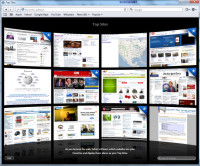 The screen of favorites starts with 12 pre-set pages, but Safari learns what your favorite pages and and swaps out the default pages with your pages.
The screen of favorites starts with 12 pre-set pages, but Safari learns what your favorite pages and and swaps out the default pages with your pages.
The display is excellent. It looks very Mac-like, similar in some ways to Itunes. But on the Mac, Safari loads quickly. On a Windows machine, it seems to take forever.
And maybe you noticed the TechByter Worldwide page in the lower right corner of the display. See how the header doesn't fit the size of the column. You might think that this is just a display problem on the iconized version of the page. But you would be wrong.
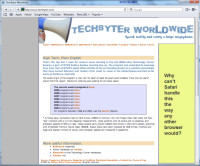 Safari seems to redefine the cascading style sheet (CSS) that defines the page elements and the relationships between the elements. The result is text that's far too small and, as a result, columns that are too narrow.
Safari seems to redefine the cascading style sheet (CSS) that defines the page elements and the relationships between the elements. The result is text that's far too small and, as a result, columns that are too narrow.
On the Mac, this page displays correctly. After some research, I determined that the problem is caused by an incorrect default value in the Safari preferences pane. Once I fixed that, the problem went away.
So before I even really started to test Safari, it was clearly an application that would not be acceptable. But one additional flaw quickly became apparent.
A few weeks ago I described how to change the icons that appear in the Task Bar. I also noted the ability to pin an icon to the Windows 7 Task Bar so that it will always be available. I did that with Safari.
![]() But when I open Safari, the program doesn't highlight the existing Task Bar icon as it should; instead, it creates another icon instance in the Task Bar. Worse still, the second instance uses the original icon.
But when I open Safari, the program doesn't highlight the existing Task Bar icon as it should; instead, it creates another icon instance in the Task Bar. Worse still, the second instance uses the original icon.
 Bottom Line: Don't sign up for this Safari if you use a PC.
Bottom Line: Don't sign up for this Safari if you use a PC.
I like Safari when it's on a Mac. Although it doesn't have add-ons that make Firefox such a powerful browser, it's faster than Firefox on the Mac. On a Windows machine, Safari is pokey, still has no add-ons, and is broken.
For Mac owners, the Safari rating is 4 cats.
For more information, visit the Safari website.
Another Ubuntu Winner: Karmic Koala
On Thanksgiving Day, I sat down in front of the notebook computer with a plan to see what had been ailing Ubuntu 9.10. Most of the difficulties were probably the result of my errors or oversights, but the bottom line is that they've been resolved and I'm once again happy with Ubuntu.
A few weeks ago I compared the latest version of Ubuntu to Windows Vista. Since then, updates and additional discoveries have changed my mind. If you have Ubuntu 9.04 installed, don't be concerned about upgrading to version 9.10.
My primary complaints:
- Ubuntu 9.10 is incredibly slow.
- I cannot enable advanced graphic support.
- Firefox is unusable.
- Applications are missing.
- I cannot easily edit GRUB (Grand Unified Boot Loader).
Here's the result of additional research:
Ubuntu 9.10 is incredibly slow.
I cannot enable advanced graphic support.
Firefox is unusable.
The first three are really, as I suspected, various symptoms of the same problem. The computer was using default (read: slow) graphics drivers. As a result, anything that wrote to the screen (that is, just about every application) was slow.
What puzzled me was that the Update Manager didn't find video drivers even though they had been present under 9.04. I thought the updater was looking everywhere, but I had failed to notice that Unsupported Updates had been deselected on the Other Software tab.
Commercial video drivers are not supported by the Ubuntu Community.
So when I selected that option and ran another update, the appropriate video drivers were installed, I could select advanced graphic support, the system was no longer sluggish, and Firefox returned to being its usual self.
That's 3 down and 2 to go.
Applications are missing.
I cannot easily edit GRUB (Grand Unified Boot Loader).
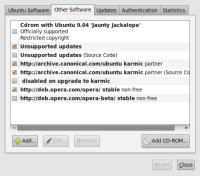 These two problems are also related. Some applications that were present under 9.04 are no longer supported and were removed. The installer warned of this, so the complaint about missing applications can be disregarded as unfounded even though it's accurate.
These two problems are also related. Some applications that were present under 9.04 are no longer supported and were removed. The installer warned of this, so the complaint about missing applications can be disregarded as unfounded even though it's accurate.
What I found most disturbing is that KGRUBEditor was missing. Or so I thought. I might have replaced it with Startup Manager. But Startup Manager wasn't on the menu either. What I didn't notice until Thanksgiving Day was that the Synaptic Package Manager either wasn't present or that I had missed it when looking through the System Administration menu.
I told the Synaptic Package Manager to reinstall the application, started it, and once again had the ability to edit the GBUB boot menu.
 Bottom Line: Ubuntu continues to lead the way for Linux users.
Bottom Line: Ubuntu continues to lead the way for Linux users.
Linux power users generally are not fans of Ubuntu Linux because the system tends to be a bit bloated. On a fast machine, you'll never notice; on a slow machine, you'll barely notice. Ubuntu remains the easiest Linux distribution for non-experts to install and maintain. After a somewhat rough start, which was mostly my fault, the Karmic Koala is cruising on my desktop and my notebook computers.
For more information, visit the Ubuntu website.
After 7-Zip, is WinZip Still an Essential Application?
For more than a decade, WinZip has been a must-have application. When I set up a computer, my process has been to install an antivirus application, an e-mail application, Firefox to replace Internet Explorer, and WinZip. Under Windows 7, and even for Windows XP or Vista, that may no longer be necessary.
WinZip 14 supports Windows 7 "libraries", which are essentially aliases that combine files and folders from one or more drives under a common theme (all music files, photos, or documents, for example). WinZip 14 can zip these libraries and extract files to libraries. Whether this will be of value to you depends on whether you use libraries and whether or not you need to compress all the files of a specific sort.
The application also understands Windows 7 jump lists, which keep recently used files and tasks within reach.
WinZip 14 includes an enhanced preview pane it's integrated with Outlook so that a user can see the contents of a zip file without leaving Outlook.
Those are the 3 most significant features and they're all worthwhile, but I'm not sure that I need any of them. WinZip is now owned by Corel, which continues to be one of my favorite companies. But I'm not so sure that WinZip 14 is worth the $30 upgrade fee. After installing the shareware version and trying it for a few days, I ended up removing it from the computer.
Alternatives
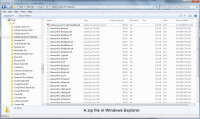 Windows 7 by itself can read and extract files from zip files. If you need additional functionality, an open-source application such as 7-Zip can provide it at no cost. At the right, the Windows 7 Explorer has opened a zip file and is displaying files that are in a compressed directory. Individual files and directories may be dragged out of the archive.
Windows 7 by itself can read and extract files from zip files. If you need additional functionality, an open-source application such as 7-Zip can provide it at no cost. At the right, the Windows 7 Explorer has opened a zip file and is displaying files that are in a compressed directory. Individual files and directories may be dragged out of the archive.
7-Zip is an open-source file archiver that, by default, creates 7z files, but can deal with most other archive formats, including zip. First released in 2000, 7-Zip was developed by Igor Pavlov. The application is distributed under the GNU Lesser General Public License and won the SourceForge.net 2007 community choice awards for "Technical Design" and for "Best Project".
My point is not to criticize WinZip, which has been and is a well designed application that has served me well and for many years. But 7-Zip is without cost and WinZip is not. 7-Zip can compress and decompress 7z, ZIP, and TAR files. While it cannot compress in the following formats it can decompress these files: ARJ, CAB, CHM, CPIO, DEB, DMG, HFS, ISO, LZH, LZMA, MSI, NSIS, RAR, RPM, UDF, WIM, XAR and Z. And more.
7-Zip in Operation
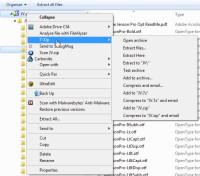 When 7-Zip is installed, you can start the application from the Start Menu or right-click an archive file to obtain a context menu with the usual selections for extracting files from the archive.
When 7-Zip is installed, you can start the application from the Start Menu or right-click an archive file to obtain a context menu with the usual selections for extracting files from the archive.
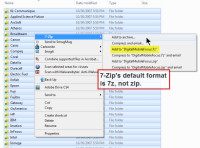 To create an archive, just select individual files or entire folders and then right-click for a context menu. 7-Zip's default format is 7z, not zip. If you want to use the zip format (or the tar format), use the top item in the context menu to open a full dialog.
To create an archive, just select individual files or entire folders and then right-click for a context menu. 7-Zip's default format is 7z, not zip. If you want to use the zip format (or the tar format), use the top item in the context menu to open a full dialog.
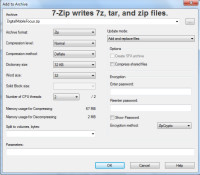 7-Zip offers a flexible and understandable archiving dialog.
7-Zip offers a flexible and understandable archiving dialog.
In addition to the usual features, 7-Zip offers performance features that allow you to control how fast the archiving process is. This involves a trade-off with system performance: Give the archiver a lot of system resources and it will finish faster, but system performance will be degraded while it's running.
You can also apply a password to the resulting file, encrypt it, or create a self-extracting archive.
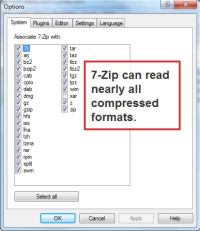 Although 7-Zip can write by default in "only" 3 formats (7z, zip, and tar), that's enough for nearly any purpose. (How many times have you needed to compress a file in the antique arj format, for example? Or lha, rar, or gzip formats?)
Although 7-Zip can write by default in "only" 3 formats (7z, zip, and tar), that's enough for nearly any purpose. (How many times have you needed to compress a file in the antique arj format, for example? Or lha, rar, or gzip formats?)
Add to that the application's ability to extract files from all well-known archive formats and you have an application that offers everything most users will need. (7-Zip can read all of those formats, along with iso files and Windows cab files.)
So, after more than a decade during which WinZip was always installed, I've found that it's no longer necessary.
 Bottom Line: 7-Zip is a full-featured archiver
Bottom Line: 7-Zip is a full-featured archiver
Although 7-Zip doesn't have WinZip's support for Windows 7 libraries, jump lists, or enhanced previews, it's a solid archiving tool that performs well. As an open-source project, it's also provided without cost.
For more information, visit the 7-Zip website.
Short Circuits
The Case of the Astonishingly Poor Fraud
Most spams, including the ones that promise millions of dollars from a bankrupt oil firm or from the survivors of a deposed leader of an African country or from a dishonest banker who found some drug money or from the dying billionaire, are unremarkable. They're usually obvious frauds, but occasionally one is so well done that it deserves special mention. On the other hand, sometimes one is prepared by someone who is so utterly inept that it deserves special mention. This is one of the latter type.
A message that was stuck in my spam trap looked interesting. "YOUR COMPENSATION PAYMENT IS READY," it shouted from the subject line. What was even more interesting was that the "to" line contained approximately 100 e-mail addresses.
Dr Tunde Lemo, who claimed to be writing from the United Nations apparently wanted to let me and the other nearly 100 recipients know that we had all been given an ATM card (number 6280 5120 0111 0686*) that contained $8.3 million.
* I suppose that I should credit the crook who wrote this with at least managing to come up with a plausible credit card number.
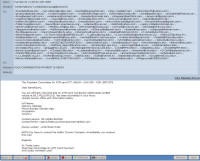 The high point of ineptitude, of course, was the fraudster's inclusion of nearly 100 addresses in the "to" line. A message such as this would clearly be sent to an individual, not a group. And although the message claimed to be from the United Nations, the actual address was "unitednationsorg@beyond.lt". The country code "lt" belongs to Lithuania. The actual domain (beyond.lt) seems to be some sort of Lithuanian game site.
The high point of ineptitude, of course, was the fraudster's inclusion of nearly 100 addresses in the "to" line. A message such as this would clearly be sent to an individual, not a group. And although the message claimed to be from the United Nations, the actual address was "unitednationsorg@beyond.lt". The country code "lt" belongs to Lithuania. The actual domain (beyond.lt) seems to be some sort of Lithuanian game site.
But pay no attention to that. To receive my $8.3 million ATM card, I would need to contact Mr James Brown. (Audio [5 seconds]) No, not that James Brown. I could do that by calling +2347034471454. Country code 234 is, as you probably already suspect, Nigeria.
"Mr James Brown" also has an e-mail address: nigeria.fedexcouriercompanyserv@ibibo.com. Ibibo.com is a social networking site in India. So somebody at the United Nations is writing to me from Lithuania to tell me that I'll receive more than $8 million from somebody in Nigeria if I just contact the Nigerian Federal Express representative who has an e-mail address at a gaming site in India.
Sure. That all seems plausible enough, doesn't it?
You Sue Me; I Sue You (or should this be "A Boy Named Sue"?)
Nokia filed suit against Apple, claiming that the computer maker had stolen 10 of the phone maker's technologies. Now Apple has filed a counter-suit that claims Nokia has used a baker's dozen of Apple technologies without permission. And Apple's suit isn't short on content when it comes to insult and abuse.
Nokia copied the Iphone, Apple says, because Nokia was losing market share in the high-end phone market as a result of concentrating on traditional cell phones when the market was moving toward smart phones.
According to Nokia, Apple is using its patented processes for making phone calls and accessing Wi-Fi networks. Nokia also claims that 40 other manufacturers have licensed Nokia technology for their phones. Apple says Nokia is using Apple's patented technologies for connecting a phone to a computer and for teleconferencing. Apple also says Nokia's menus and power conservation technologies were invented by Apple.
Both suits were filed in federal court in Delaware, a state where nearly all large corporations set up shop because of laws that favor big businesses.


 The author's image: It's that photo over at the right. This explains why TechByter Worldwide was never on television, doesn't it?
The author's image: It's that photo over at the right. This explains why TechByter Worldwide was never on television, doesn't it?
